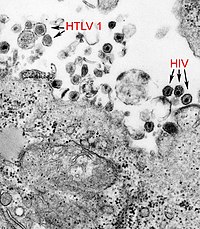
Photo from wikipedia
Background & aim There is evidence that maternal viral load of HCV during delivery influences the risk for Mother-to-child transmission (MTCT), but this does not explain all cases. We study… Click to show full abstract
Background & aim There is evidence that maternal viral load of HCV during delivery influences the risk for Mother-to-child transmission (MTCT), but this does not explain all cases. We study the role of the immunogenetic profile (HLA, KIRs and KIR-ligand binding) of mothers and children in HCV-MTCT and in chronicity in the children. Methodology 79 HCV-RNA (+) mothers and their 98 children were included. 24 children were infected, becoming chronic in 8 cases and clearing in 16. HLA-class-I and II and KIRs were determined by Luminex. Results MTCT study: The presence of HLA-C1-ligand in mothers and/or their children reduces the risk of transmission (mothers: Pc = 0.011, children: P = 0.033), whereas the presence of HLA-C2C2-ligand in mothers increases it (Pc = 0.011). In children KIR2DL3-HLA-C1 is a protector factor (Pc = 0.011). Chronicity in children study: Maternal DQA1*01 allele (Pc = 0.027), KIR2DS1 (Pc = 0.011) or KIR3DS1 (Pc = 0.011) favours chronicity in the child. The presence of the DQB1*03 allele (Pc = 0.027) and KIR2DS3 (P = 0.056) in the child and homozygosity for KIR3DL1/3DL1 (Pc = 0.011) and for the HLA-Bw4/Bw4 ligand (P = 0.027) is associated with viral clearance, whereas the presence of HLA-Bw6 ligand (P = 0.027), the binding of KIR3DS1-HLA-Bw4 (P = 0.037) and heterozygosity for KIR3DL1/3DS1 (Pc = 0.011) favour viral chronicity. Mother/child allele matching: In the joint HLA analysis, matching was greater between mothers and children with chronic infection vs those who had cleared the virus (67%±4.1 vs 57%±1.2, P = 0.003). Conclusions The HLA-C1 ligand in the mother is related to MTCT, while several genetic factors of the mother or child are involved in the chronification or clearance of infection in the child. Matching allelic data is considered to be an indicator of HCV chronicity in the child and can be used as a potential prognostic test. This implies that NK cells may play a previously undocumented role in protecting against MTCT and that both NK cell immunity and adaptive T-cell responses may influence viral clearance in infected children.
Journal Title: PLoS ONE
Year Published: 2017
Link to full text (if available)
Share on Social Media: Sign Up to like & get
recommendations!